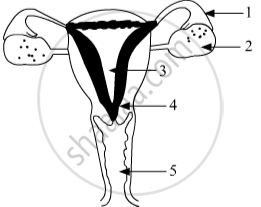Advertisements
Advertisements
Question
Choose the Odd One Out:
Options
Testes
Prostate gland
Seminal vesicle
Cowper’s gland
Solution
Testes
APPEARS IN
RELATED QUESTIONS
Write the functions of the following parts in human female reproductive system:-
(i) Ovary
(ii) Oviduct
(iii) Uterus
Describe in brief what happens to the zygote after it gets implanted.
What is puberty? Who attains puberty at an earlier age in human beings : male or female (boy or girl)?
The diagram shows female reproductive system. Name the parts labelled A to D.
(a) In which part do the sperms enter?
(b) Which part releases the egg?
(c) In which part does fertilisation take place?
(d) In which part does the foetus develop?

What changes are seen in boys at the time of puberty?
What is the role of seminal vesicles and prostrate gland in human male reproductive system?
When a fertilised egg E formed in the oviduct of a human female divides repeatedly to form an embryo, the embryo gets implanted in the thick and soft lining of the uterus. After this a disc-like special tissue T develops between the uterus wall and embryo through which all the requirements of the developing embryo (and foetus) are met from the mother's body, The embryo is connected to the tissue T through a string like structure S.
(a) What is the other name of fertilised egg cell E?
(b) What is the name of tissue T?
(c) Name the string-like structure S.
(d) Name two substances which pass from mother's blood to embryo through tissue T and, one type of substance which passes from embryo to mother's blood.
(e) What happens to S when the baby is born? Why?
Mention the two functions of human testis.
Identify the given diagram.
Name the parts 1 to 5. 
Choose the Odd One Out:
